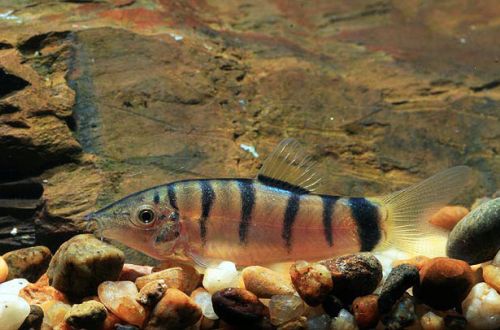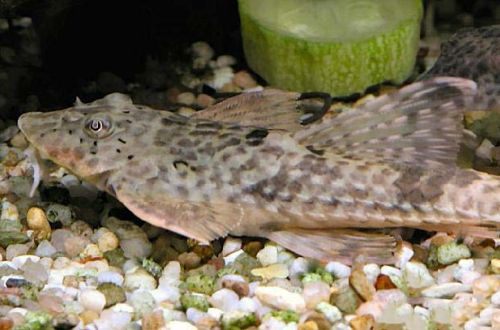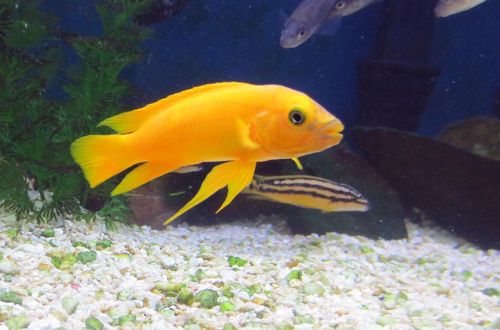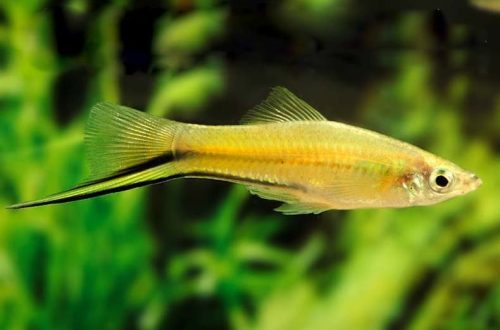
Botsia morletti
Botsia Morleti or Ribbon Botsia, also known as Bocilia Skunk. The scientific name Yasuhikotakia morleti belongs to the Cobitidae family. Relatively peaceful fish, if you pick up suitable neighbors. A rather nondescript color is compensated by unpretentiousness and simplicity in maintenance.

Contents
Habitat
Comes from Southeast Asia. It lives in the vast basins of the Mekong and Chao Phraya rivers on the territory of modern Cambodia, Thailand, Laos, and Vietnam. Seasonal migrations of this fish led to a wide habitat. Ribbon botia is found both in the main channel of rivers along their entire length, and in temporarily flooded coastal areas.
Brief information:
- The volume of the aquarium – from 100 liters.
- Temperature – 23-28°C
- Value pH — 6.0–7.5
- Water hardness – soft (2-12 dGH)
- Substrate type – any
- Lighting – subdued
- Brackish water – no
- Water movement – moderate
- The size of the fish is up to 8 cm.
- Nutrition – any drowning
- Temperament – conditionally peaceful
- Content in a group of at least 5 individuals
Description
Adult individuals reach a length of about 7–8 cm. Sexual dimorphism is weakly expressed. Distinguishing a male from a female is quite problematic. Near the mouth are sensitive antennae, with the help of which the fish searches for food among the particles of the soil. The main color is white with a yellow or golden hue. Juveniles have vertical stripes on the sides of the body. In the adult state, only a black stripe remains, running along the entire back of the fish, and a “belt” at the base of the tail.
Food
Botsia morleti is not picky about the diet. Accepts any sinking food, such as dry flakes or granules, as well as frozen daphnia, bloodworms, brine shrimp, pieces of earthworms, molluscs. It is important that the composition of the feed must contain plant components.
Maintenance and care, arrangement of the aquarium
The optimal size of the aquarium for a group of 5 fish starts from 100 liters. The design is arbitrary, subject to the following conditions: the presence of soft sandy soil and various shelters. If you want to make the aquarium look like a natural habitat, then you can use the same sandy substrate with a few smooth stones mixed with pebbles. Place snags in the form of roots, branches and other fragments of the tree. Plant shade-loving plants such as Java and Malayan ferns, Anubias, Java moss, etc.
The aquarium should be equipped with a tight lid to avoid accidental jumping out of the fish. When keeping, it is important to ensure high water quality, moderate current and good oxygenation. It is necessary to replace part of the water weekly (30–50% of the volume) with fresh water and regularly remove organic waste.
Behavior and Compatibility
When kept alone, they become aggressive, it is advisable to acquire a group of 5 or more individuals. The best number is more than 10 fish. Botsia morleti calmly treats relatives and representatives of other related species. As for the selection of neighbors not from among the Goltsov, then here you need to be careful. It is worth avoiding the introduction of fish of a similar size that live in the bottom layer, for example, Corydoras catfish. A good combination is obtained with species that stay in the upper layers of the water, or with fairly large, but peaceful fish.
Breeding / breeding
Breeding in a home aquarium is not possible. In the wild, the breeding season is preceded by a long annual migration (November-December) and a consistent change in hydrochemical conditions, which cannot be recreated within a single aquarium. In commercial fish farms, special hormonal injections are used to produce offspring.
Fish diseases
Health problems arise only in case of injuries or when kept in unsuitable conditions, which depresses the immune system and, as a result, provokes the occurrence of any disease. In the event of the appearance of the first symptoms, first of all, it is necessary to check the water for the excess of certain indicators or the presence of dangerous concentrations of toxic substances (nitrites, nitrates, ammonium, etc.). If deviations are found, bring all values back to normal and only then proceed with treatment. Read more about symptoms and treatments in the Aquarium Fish Diseases section.





